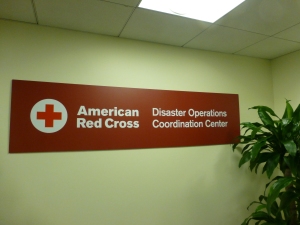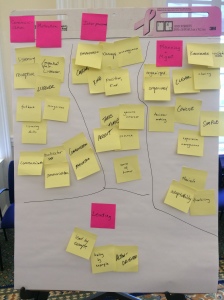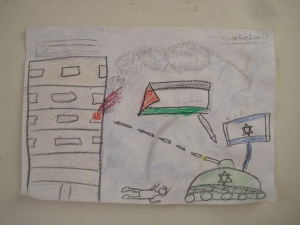At the beginning of July it hit me: My Fulbright year will come to an end soon. To make the most out of my remaining weeks at the American Red Cross National Headquarters, I decided to finally take time to visit the Disaster Operation Coordination Center and signed up for two trainings.
Disaster Operations Coordination Center Visit
The American Red Cross was chartered by the United States Congress to “carry on a system of national and international relief in time of peace”. It helps annually the victims of nearly 70,000 disasters. While most of the disaster relief happens locally all around the country, the Disaster Operations Coordination Center (DOCC) at the National Headquarters in DC has an important role as the nerve center of the national support.
When large-scale disasters happen, DOCC is staffed 24/7 coordinating the relief efforts, collaborating with authorities, handling disaster fundraising, and supporting the local chapters in any way they can. Even if I knew a lot about this in theory, seeing the actual DOCC with its storm proof windows, numerous computer screens and gigantic printers for printing out maps to visualize where and how hard the disaster hit made the mission feel much more real. During the visit I learned DOCC is so crucial and respected a player in disaster response that there even is a dedicated phone line between DOCC and the White House, and President Obama himself visited DOCC during the Hurricane Sandy.
The Digital Operations Center, DigiDOC, is a recent addition to DOCC, its little brother if you will. A small team of NHQ staff and a small army of volunteers work on social media data to map how disasters are unfolding and even to reach out to individuals needing help and support through Twitter. Have a look at this short video to see how cool it is!
The International Response Operations Center, IROC, is also co-located with DOCC. IROC works together with the International Federation of Red Cross (IFRC), International Committee of Red Cross (ICRC), and national Red Cross and Red Crescent societies to channel the support of the Americans to where it is most needed. Again, seeing the current disaster response and preventive projects on a huge world map made it much more concrete on how many fronts the American Red Cross is present. Talking about a motivational boost!
Supervising Volunteers Workshop
Over 90% of the American Red Cross workforce consists of volunteers. Supervisors of volunteers naturally have a tremendous impact on volunteer motivation and satisfaction, and consequently an enormous influence on the success of organization. At the American Red Cross, the critical role of supervisors of volunteers is recognized, and they are offered specific volunteer management training in the form of a Supervising Volunteers workshop.
When I heard that this workshop would be offered at the headquarters for any employee or volunteer who currently supervises, or is interested in supervising volunteers, it was a no-brainer for me to sign up. During my years at Booz Allen and Nokia, I had the privilege to participate regularly in different types of leadership and management trainings. I enjoyed all of them, and each time I learned something new about leading myself and leading others. This time I was particularly curious to learn about the differences between supervising employees and volunteers.
The workshop covered a number of carefully selected volunteer management topics such as how to balance leadership and management, characteristics of an effective volunteer supervisor, how to use coaching effectively, how to identify your strengths, and how to use them as a supervisor of volunteers. The differences between supervising employees and volunteers turned out to be rather minor: after all, both employees and volunteers are human-beings, so you can’t go very wrong with an appreciative, organized and reliable approach.
Meeting people who work or volunteer in different parts of the American Red Cross was a big additional bonus. We had great conversations in small cross-functional teams on how to engage volunteers in satisfying and fulfilling work, how to keep them coming back, and how to deal with difficult situations.
My favorite part of the training was a strength identification exercise based on Bernard Haldane‘s theory of ‘dependable strengths’. Haldane created the theory in the late 1940s to support WWII veterans’ employment in civil jobs after the war. It turned out to work well also as a part of our training. The exercise takes only 7 minutes, but it can give you a whole new perspective to your strengths. If anyone wants to give it a go, please let me know!
International Humanitarian Law Training
When I signed up for a training on International Humanitarian Law (IHL), I had no idea how sadly topical it would be at the time of the training. The tragic flight MH17 was shot down in Ukraine the day before, and Israel had just sent ground troops into Gaza as a part of its Operation Protective Edge against Hamas, resulting to quickly rising death toll of Palestinian civilians. I was not completely unfamiliar with the rules of war before the training, but it was tremendously helpful to spend some time going through the details to be better equipped to understand what is going on.
In brief, International Humanitarian Law, also known “law of armed conflict”, is a set of rules which seek to limit the effects of armed conflict for humanitarian reasons. The Geneva Conventions of 1949 and their Additional Protocols provide the foundation for the legal regime. These rules protect persons who are not or are no longer participating in hostilities, in other words civilians, prisoners of war, wounded soldiers, and also shipwrecked. They also restrict the means and methods of warfare, like weapons that cause deaths and injuries long after conflicts have ended.
IHL is widely adopted, not only by every nation, but also by many other armed groups and even private security companies. Why do all these parties respect IHL, or at least claim that they do? The list of reasons is long ranging from public opinion and military efficiency to reciprocity, ethical values, and “because it is the right thing to do“. However, like the recent examples from Ukraine and Gaza show, unfortunately the rules of war are not always followed, and innocent civilians become victims of armed conflicts.
The Red Cross movement works hard to raise the awareness of the rules of war by providing education for various audiences from military members and conscripts to teachers, school kids, and law and policy makers. The International Committee of Red Cross (ICRC) is the only institution explicitly named under International Humanitarian Law as a controlling authority. In addition to promoting IHL, ICRC works tirelessly in conflict areas to alleviate human suffering by providing safe water, food and medical assistance, transmitting messages between separated family members, reuniting dispersed families, and visiting detainees. Knowing all this does not make me feel much less helpless hearing the horrible news from conflict areas, but at least it gives some hope.



Recent Comments